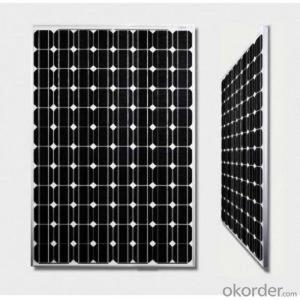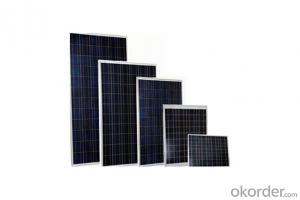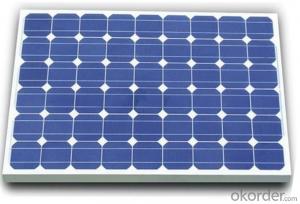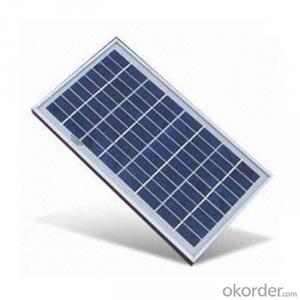Solar Panel 235Wp special for Off-grid Solar Power System Paneles Solares
- Loading Port:
- China main port
- Payment Terms:
- TT OR LC
- Min Order Qty:
- 700 watt
- Supply Capability:
- 20000000 watt/month
OKorder Service Pledge
OKorder Financial Service
You Might Also Like
Solar Panel 235Wp special for Off-grid Solar Power System Paneles Solares
Product Pictures
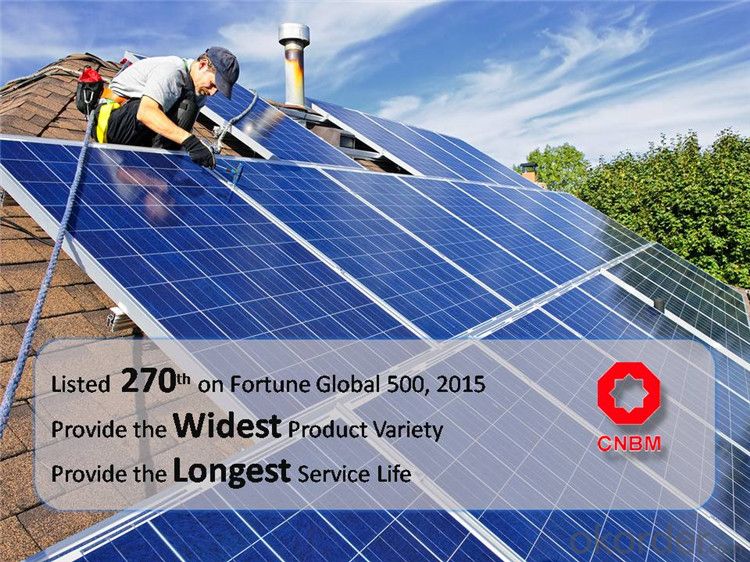
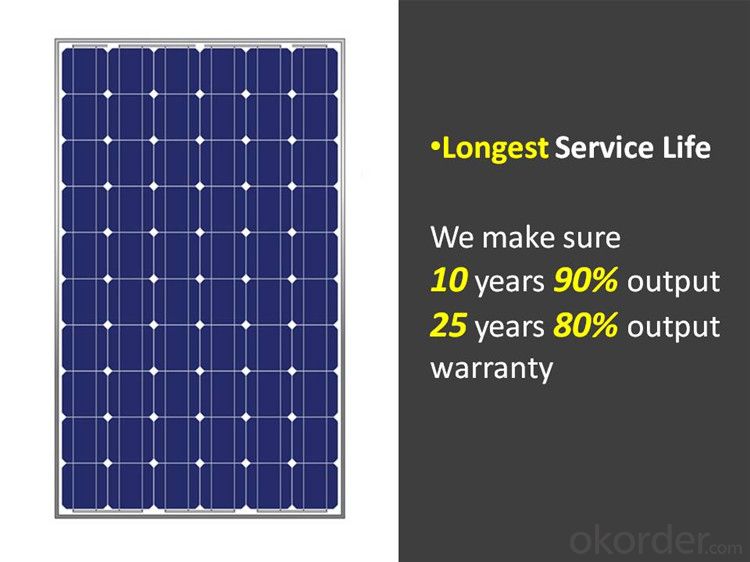

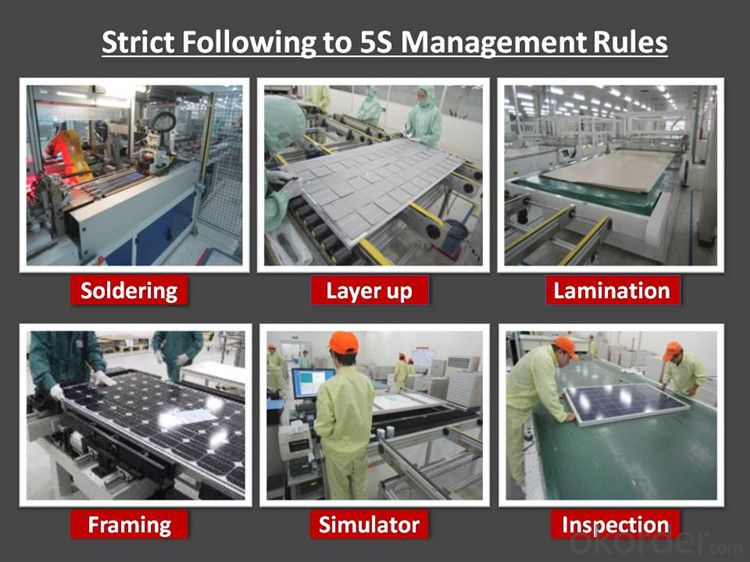


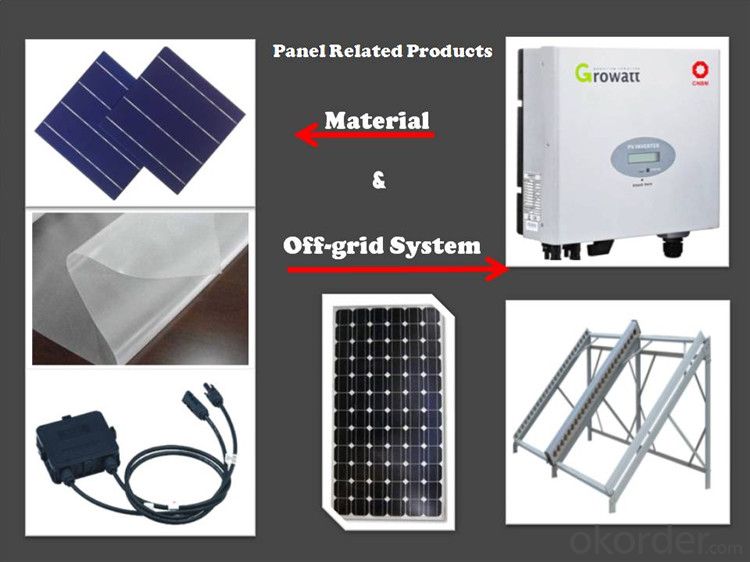

Mechanical Characteristics
Peak power (Pmax) | 10W |
Power tolerance | ±5% |
Max. system voltage | 1000VDC |
Open circuit voltage (Voc) | 21.4V |
Short circuit current (Isc) | 613mA |
Max. power voltage (Vmp) | 18V |
Max. power current (Imp) | 0.557A |
Cell Efficiency | >16% |
Standard Test Condition (STD) | Irradiance:1000W/m2;Cell temperature:25℃; AM:1.5 |
Operating temperature | -40 to+ 85℃ |
Applications
Commercial/ industrial building PV solar roof-top off-grid systems.
Residential PV solar roof-top off-grid systems.
Any commercial / industrial ground mount off-grid systems.
Other off-grid industrial and commercial solar PV applications.
Warranty
10 year limited product warranty on materials and workmanship.
25 year limited power warranty on power output.
≥90% power output assurance for 10 years and ≥80% power output assurance for 25 years.
Refer to warranty document for detailed warranty information.
- Q:So idk how to connect a solar panel to a battery ...is it like a series connection from the solar panel to the battery, or a parallel connection from solar cell to battery? (to charge) please and thank you
- it depends how big the panel is. a small trickle charger (like a 2W panel with built-in diode), just connect + to + and - to - (parallel) to trickle charge the battery. The diode will keep the batter from discharging through the panel when there is insufficient sunlight. for a large panel (like a 220W 24v panel), you best go through a charge controller. the charge controller has 2 leads for the solar panel input, 2 leads for the battery connection and 2 leads for the 2v load. just follow the instructions to connect the panel and battery to the controller, and MAKE SURE YOU USE THE REQUIRED FUSES. very straightforward stuff -- just RTFM
- Q:I recently bought a house with very old solar panels (about 25 years old) that don't appear to work properly. They are supposed to heat the hot water heater but they don't always work, and recently have staretd leaking. So, I have had them turned off and now we're just using electricity to heat the hot water. My question is, is there any tax credit money (stimulus or otherwise) available for people to (a) repair old solar panels or (b) replace them with new ones? How does the credit work?
- Congratulations okorder /
- Q:Can solar panels be installed on a museum or cultural institution?
- Yes, solar panels can be installed on a museum or cultural institution. Installing solar panels can help these institutions reduce their energy costs and carbon footprint, while also showcasing their commitment to sustainability and environmental stewardship. Additionally, solar panels can be installed on rooftops or in nearby open spaces, minimizing any aesthetic impact on the museum's architecture or surrounding areas.
- Q:How do solar panel power systems work?
- Solar power works by making solar cells of two kinds of glass; one which has been “doped” to have too many electrons, and the other which has been “doped” to have too few electrons. These layers of glass are then glued together with a thin insulation layer in between them. The top layer of glass is the one with too many electrons, the bottom layer of glass has too few electrons, and the insulation allows electrons to pass from the bottom layer to the top layer easily, but not from the top layer to the bottom layer as easily. As photons come flying into this glass sandwich at the speed of light, the photons crash into the electrons in both layers and cause them to start moving. The electrons in the top layer are tightly packed and can’t move much, but the electrons in the bottom layer can move around enough that they end up crossing through the insulation into the top layer. However, because there are already too many electrons in the top layer, the newly arrived electrons have no place to rest. This buildup of electrons creates an “electrical pressure”. Then contacts are glued to the glass top and bottom, and a wire is added to connect the top layer to the bottom, and the electrical pressure which has built up in the top layer now has a way to escape, and the extra electrons which crossed over the bottom to the top can now return to the bottom layer. This flow of electrons from the top layer to the bottom layer is the electricity generated by the solar cell. A solar “panel” is made up of many of these cells wired in series to increase the voltage to make it high enough to do some useful work, such as charging batteries, and many of these panels can be wired together to do such things as supplying power to a building, or even supplying power to the utility grid.
- Q:Are there any tax credits available for installing solar panels?
- Yes, there are tax credits available for installing solar panels.
- Q:are there solar panel that work without the sun?
- There cannot be a solar panel which works without sun light. But solar panels can work without sunlight. For example you would have seen the battery less calculators which work on solar power. they work in the night too with enough light coming from the bulbs in the room. So the answer to your question in yes. But for generating power we have to have a source which is free and we cannot put the panel in lighted area, which will make is not economical since the nett power obtained will be negative.
- Q:I'm from Toledo, OH about 2 miles from the MI line. We are a foster family and have adopted 5 children. We just moved into a 5400+sq 2 story home. We have (3) 2.5-3 ton AC units to cool this huge house. We got the house cheap...$75k couldn't pass it up! Anyway...I was wondering how many solar panels it would take and of what wattage to power these Central Air Units and maybe the rest of the house. We have 3 people in our home......9 of which are children who leave the lights on and run hot water to beat the band. We have all brand new energy star appliances and front loader washer and dryer. Gas Range and Gas hot water tank. Was thinking of using metal window frames and buying solar cells and making my own panels. Just don't know how much to buy. We face south with no trees. Constant Sun. thanks for your help. An e-mail address to bounce questions off of would be helpful if you experienced. tx.
- Basically, the answer to your question is forget it. Your approx 8 tons of AC will require about 28 KW of electricity just to run them. Add the rest of the house requirements and your talking a load of 50KW or more. Even if your state has a subsidy program, (and most of them are out of money now), it's a $200,000. system. Making your own panels would be a mistake. Reliability and survival are the key measures for a panel system and homemade panels are just not going to be reliable enough to survive the cold winters. In the end, it is always cheaper to buy good, conservatively rated commercial panels, especially in view of the fact that prices have been tumbling lately. Often, the mounting, interface and conversion costs are greater than the cost of the panels themselves. You might save some bucks by fabricating a mounting framework yourself and installing it, but such a system would not qualify for most state programs and.... you had better be an expert architect or engineer to put together something that will work well. The basic problem after all of this is that your maximum demand will be at night and the panels put out nothing at night. Better to forget about a 00% solution. You can install a modest 0 - 20KW system for perhaps $50,000 costs after rebates and subsidies and perhaps ... it might cover about /4 of your energy needs and might just, pay the investment back in 0 to 5 years. Get first rate equipment and professional installation, if you want the system to perform reliably. Solar voltaics make a lot of sense for Arizona and perhaps Florida. For anyone north of the Mason Dixon line however, fossil fuels are cheap, reliable and work far better.
- Q:i have a fountain system that has a small electric pump. its made to be close to a house but i want it across the driveway and i dont want to run electrical over there.is there a small solar panel that i can get fairly inexpensive to mount on a nearby tree and be able to plug the pump into it?
- Home Depot has several sizes for applications such as yours in the gardening section. Because I am always looking for ways to save money, even in the long run, I was looking at the possibility of solar power for here in SW FL.
- Q:How much energy can solar panels produce?
- The amount of energy that solar panels can produce varies depending on various factors such as the size and efficiency of the panels, the location, and weather conditions. However, on average, a typical residential solar panel system can generate around 10 to 12 kilowatt-hours (kWh) of electricity per square meter per day.
- Q:How do solar panels affect the insurance premiums of a home?
- Solar panels can potentially affect the insurance premiums of a home in a positive way. While the upfront cost of installing solar panels may increase the overall value of the property, insurance companies often view solar panels as a risk-reducing feature. This is because they can decrease the home's reliance on traditional energy sources and potentially lower the risk of fire or electrical damage. As a result, homeowners may be eligible for certain insurance discounts or reduced premiums, depending on the insurance provider and policy.
1. Manufacturer Overview |
|
|---|---|
| Location | |
| Year Established | |
| Annual Output Value | |
| Main Markets | |
| Company Certifications | |
2. Manufacturer Certificates |
|
|---|---|
| a) Certification Name | |
| Range | |
| Reference | |
| Validity Period | |
3. Manufacturer Capability |
|
|---|---|
| a)Trade Capacity | |
| Nearest Port | |
| Export Percentage | |
| No.of Employees in Trade Department | |
| Language Spoken: | |
| b)Factory Information | |
| Factory Size: | |
| No. of Production Lines | |
| Contract Manufacturing | |
| Product Price Range | |
Send your message to us
Solar Panel 235Wp special for Off-grid Solar Power System Paneles Solares
- Loading Port:
- China main port
- Payment Terms:
- TT OR LC
- Min Order Qty:
- 700 watt
- Supply Capability:
- 20000000 watt/month
OKorder Service Pledge
OKorder Financial Service
Similar products
New products
Hot products
Related keywords
